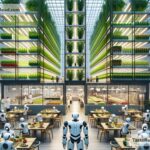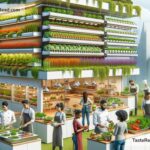The Future of Food and Inclusive Systemic Innovation
Food is one of humanity’s most basic needs, and yet the way we grow, distribute, and consume food is constantly changing. In the future, food will continue to evolve, driven by new technologies, sustainability concerns, and the need to feed a growing global population. But as these changes take place, it will be important to ensure that everyone is included in this transformation. Inclusive systemic innovation — making sure that food systems work for all people, regardless of their background or circumstances — could hold the key to solving the biggest food challenges we face today and in the future.
The Growing Challenges in Food Systems
As the world’s population rises to nearly 10 billion by 2050, feeding everyone will become more difficult. Climate change is already affecting the way we grow crops, with unpredictable weather patterns and rising temperatures causing droughts, floods, and other challenges for farmers. At the same time, the way humans eat is shifting; more people are choosing plant-based diets, while others demand faster, more convenient food options.
Add to this the issue of inequality. Millions still face hunger and malnutrition, while wasteful practices lead to tons of perfectly good food being thrown away every day. How can we create a future where everyone — from farmers to consumers — benefits from innovation in food systems?
Rethinking Food Production and Technology
Technology is playing a big role in shaping the future of food. Scientists and engineers are coming up with new ways to produce food using fewer resources, which could help reduce the impact of farming on the planet. For example:
-
Vertical Farming: Imagine rows of crops growing indoors inside tall buildings, using controlled temperatures and LED lights instead of sunlight. Vertical farming is already helping reduce the space and water needed for agriculture.
-
Lab-Grown Meat: Researchers are creating meat from cells instead of raising animals. This process could reduce greenhouse gas emissions and land use, and may help meet the growing demand for proteins in a sustainable way.
-
AI and Drones: Artificial intelligence (AI) and drones are being used to monitor crops, predict weather changes, and help farmers reduce waste by managing resources more efficiently.
These innovations are exciting, but they also raise questions about access. Technologies like lab-grown meat and vertical farms are expensive to develop and implement. How can we ensure that these advances benefit people in low-income communities or in countries with fewer resources?
Food Sustainability and the Planet
The future of food must also focus on sustainability. Agriculture is currently responsible for large amounts of greenhouse gas emissions, water use, and biodiversity loss. To meet future needs while protecting the planet, we need solutions that prioritize the environment. Sustainable approaches like regenerative agriculture — which focuses on maintaining soil health and ecosystems — could play a big role here.
Making food systems more sustainable isn’t just a technical challenge; it’s also about creating fairness. Poor communities are often hit hardest by environmental problems, such as drought or flooding. Inclusive systemic innovation means designing solutions that work for people in these communities and ensuring they have the tools and resources to adapt.
Making Food Systems Inclusive
Innovation in food systems shouldn’t just be about new technologies; it should also include people. Food is about culture, tradition, and communities. Inclusive food systems mean giving everyone, from small-scale farmers to urban consumers, a voice in shaping the future of food.
One way to encourage inclusivity is through education and partnerships. Farmers in rural areas, for example, may not have access to advanced technology, but with training programs and initiatives that share knowledge, they can adopt sustainable methods. Communities can also create local food hubs or cooperatives that allow farmers and consumers to connect directly, reducing waste and encouraging fair prices for producers.
Technology can also help bridge gaps. Mobile apps, for instance, can help farmers sell their products online, while blockchain technology can ensure transparency in supply chains so farmers earn fair wages and consumers know exactly where their food comes from.
Innovations That Reflect Diversity
Food diversity is another important piece of the puzzle. Around the world, people eat different types of food, and their diets are shaped by culture, geography, and tradition. Preserving this diversity in the face of climate change and globalization is crucial, particularly for marginalized communities.
Efforts like seed banks, which store and protect seeds from various plants, can help preserve local knowledge and ensure that traditional crops aren’t lost over time. Governments, companies, and nonprofits can work together to promote crops that grow well in specific regions, rather than relying exclusively on imported foods or mass-produced staples.
Moving Forward Together
The future of food is a shared challenge, one that involves everyone — farmers, scientists, policymakers, businesses, and consumers. Inclusive systemic innovation is about creating food systems that work for all people, regardless of their income, location, or identity.
By adopting new technologies, promoting sustainability, and fostering collaboration, we can address the big challenges in food systems while ensuring that no one is left behind. Whether it’s through creating affordable technologies, supporting small farmers, or fighting food waste, the goal is to create systems that are fair, resilient, and accessible to everyone. In the end, food isn’t just about survival; it’s about connection, culture, and community.
The choices we make today will shape what — and how — we eat tomorrow. With inclusive systemic innovation, we can ensure a future where food systems are better for people and the planet.


